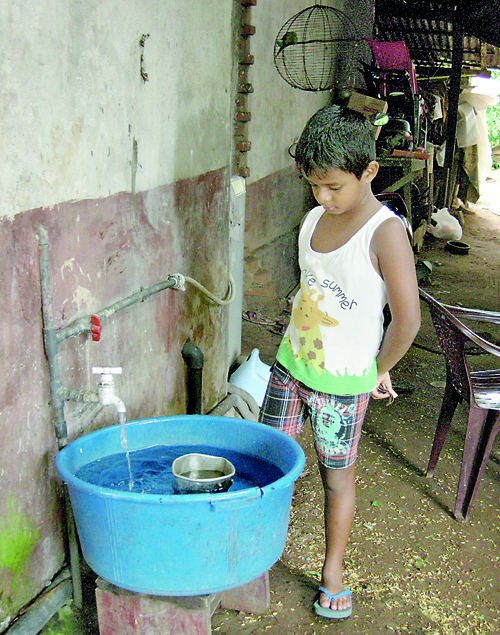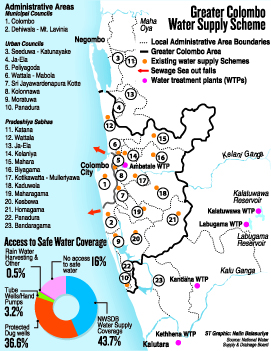News
Roads authority ducks decision while a district runs dry
Residents of Hendala, Wattala, were forced to wait a week without running water because the roads authority looked for someone sufficiently senior to give the Water Board permission to dig up a road and repair pipes – in the end the board went ahead regardless.
Residents were forced to collect water distributed from bowsers, depend on tube well water from neighbours or visit relatives and friends houses to collect water during the breakdown of supplies.
Leaking pipelines are not uncommon in some areas of Greater Colombo and the suburbs where regular water cuts are announced.
“The reason for the prolonged delay in restoring supplies (in Hendala, Wattala) was the Road Development Authority (RDA) not giving approval to the Water Board to carry out repairs in the underground water supply line on Canal Road, the parallel road to the

Water at last: A little boy in Wattala waits till a bucket fills when finally water trickles in after a water cut. Pic by Athula Devapriya
Hamilton Canal in the Elakanda area,” an area engineer attached to the Kelaniya Water Board office, Ms D. Hapuaarachchi, said.
She said the Water Board office in Kelaniya was continuing with the repairs despite not receiving approval from road authorities.
“We waited for several days for the RDA to respond, and in their failure we carried out the repairs on Wednesday after sending a letter to RDA,” Ms. Hapuaarachchi said.
“The RDA made the road of concrete. Regional officers of the RDA informed us that if the road is a carpeted (macadamised) one, then approval can be given. But if it is made of concrete, then approval should be obtained from higher officials.
“The RDA did not shift the pipes when laying the concrete road.”
Ms. Hapuaarachchi said the pipelines along that road dated from the 1960s and were made of asbestos and cast iron.
“This is the same issue with the Kandy road. There are many pipelines that are laid under the main road there.
“Road projects should include funding for shifting water pipes. The Water Board cannot bear the cost of digging up and moving 7-8 km stretches of pipeline,” the engineer said.
The week-long water cut in Hendala directly affected more than 400 families while surrounding areas experienced low pressure water supply.
Namal Sunanda, a resident, said many people had to travel to the houses of nearby friends and relatives to get clean drinking water, and to the nearest public well to collect water for washing.
Most people using overhead tanks also faced difficulties.
“There are houses with upper floors rented out, where the water supplied is through overhead tanks which were not getting filled. The water pressure in surrounding areas was also low,” Mr Sunanda said.
 Another resident, Radhika Jeyaprakash, said that with two infants in their house, clean water was a major concern.
Another resident, Radhika Jeyaprakash, said that with two infants in their house, clean water was a major concern.
“The tube well water was unusable for several days. We used bottled water for drinking, to prepare meals and wash baby clothes. As this was expensive we also opted to travel to our brother’s house in Kelaniya to bring drinking water. It was a hectic week,” said Radhika.
K. Nilmini is a mother of two, was seen desperately collecting water in several large containers in her garden.
“We don’t have a tank so this is the only water we have. I hope the water supply is restored,” she said.
According to the Census and Statistics Department only 40 per cent of the population has organised water supply facilities. The Government’s target is to provide safe drinking water for everyone in 2025, with 60 per cent of the target to be met by 2020.
The Water Board, however, faces many challenges and obstacles, especially in the Western Province where there is rapid road development as well as other development work including apartment complexes.
The Additional General Manager (Western) of the National Water Supply and Drainage Board and former chief engineer for the Western Province, N. M. S. Kalinga, said the Elakanda water line laid in the late 1950s had a width of only two inches at the starting point and narrowed to one inch along its length.
“There were no drawings of the pipeline laid under marshy lands. The concrete road was laid recently by the RDA under the area development project. Now the Water Board is in the process of identifying underground water lines,” he said.
Three water lines will be directed into the area.
Mr. Kalinga said the low pressure problem in the Wattala area was due to increasing peak-hour consumption.
“Previously, water was supplied to Wattala through a 900mm water line. The Board is planning to connect the supply to a 1200mm line by the end of this month. We will keep studying the water supply to this area,” he said.
He said there were about 700,000 connections in the Colombo district, Gampaha had 199,000 connections and the Kalutara district, 200,000 connections. Of these, the Water Board supplied water directly to 800,000 connections while others were community-based water projects.
“Greater Colombo has about 800km of water lines lying underground, with some about a century old. As there are no drawings showing all the lines, the Water Board is struggling to locate and replace lines at a high cost,” he said.
Mr. Kalinga said on May 27 and 28, water cuts will be imposed along the Galle Road from Bambalapitiya to the Dickman’s Road junction as water lines were being replaced on the road.
“Road development and local government authorities should work together with the Water Board, especially when implementing development projects, in order to avoid inconvenience to the public,” he said.

